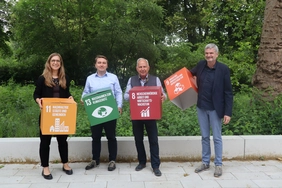This year's Neuburg Sustainability Talks concluded on 11 June with an event on climate-adapted and climate-resistant construction. The well-filled rows, the interested audience and the lively discussions testified to the great interest in the topic.
Prof Dr Andreas Haese from Technische Hochschule Ingolstadt (THI) began by highlighting the growing significance of climate extremes from a building perspective. Progressive climate change is increasing the probability of extreme weather events such as flooding, heavy rain, storms, wind, hail and heat, which can potentially cause damage to buildings. Against this background, buildings of the future must be designed in such a way that they can withstand these dangers.
Felix Denzinger, graduate engineer for architecture, pointed out the many conflicting objectives. For example, buildings should not only be recyclable, efficient and durable, but should also conserve resources. These requirements are not always compatible.
An important approach to heat resistance in cities is the greening of façades, roofs and open spaces, as Simone Linke, Professor of Urban Planning and Landscape at Weihenstephan-Triesdorf University of Applied Sciences, explained. Greenery can serve as a water reservoir, protect building façades, lower temperatures and act as a natural filter for pollutants and carbon dioxide. However, Linke emphasised that putting scientific findings into practice is often challenging and that sustainable urban development is difficult to implement without a change in traffic patterns. The need for car parking spaces must be reduced in order to use land for other purposes and make cities more climate-resilient and liveable.
Walter Lenk from the Gemeinnützige Bau- und Siedlungsgenossenschaft für den Landkreis Neuburg-Schrobenhausen presented an impressive example of good practice: a redensification project in a housing estate in Neuburg, which has been described in the media as a "lighthouse project". The building has a positive land balance - more area was unsealed than sealed - and has a sustainable heat supply and water infiltration concept as well as a green flat roof.
Dipl.-Ing. Felix Denzinger used an example from Ingolstadt to show which sustainable building concepts are possible in existing buildings. There, a student residence in timber construction was built on a former supermarket, while the vacant basement floors were converted into an underground car park.
Climate adaptation in listed buildings is another complex challenge. Here, the focus is often on preserving the historic appearance, but historic city centres can also be made more climate-resilient. Prof. Dr Linke emphasised that climate adaptation is a local issue and requires a rethink in all areas.
This last successful event concluded this year's series of Neuburg Sustainability Talks.
Further information on the dialogue rounds can be found at www.thi.de/NNG.
The Neuburger Nachhaltigkeitsgespräche were organised by the "Mensch in Bewegung" project.


![[Translate to English:] Logo Akkreditierungsrat: Systemakkreditiert](/fileadmin/_processed_/2/8/csm_AR-Siegel_Systemakkreditierung_bc4ea3377d.webp)








![[Translate to English:] Logo IHK Ausbildungsbetrieb 2023](/fileadmin/_processed_/6/0/csm_IHK_Ausbildungsbetrieb_digital_2023_6850f47537.webp)


